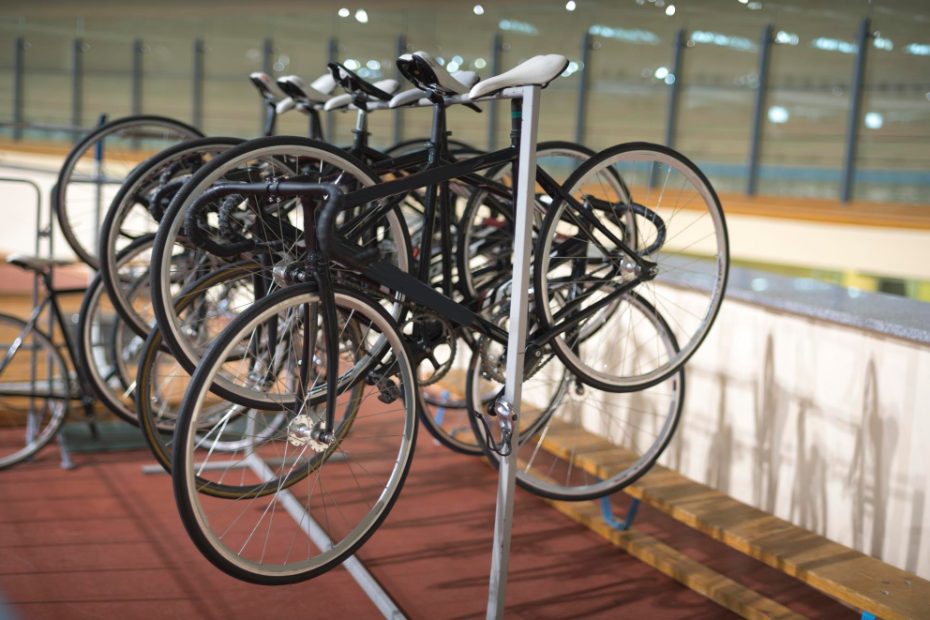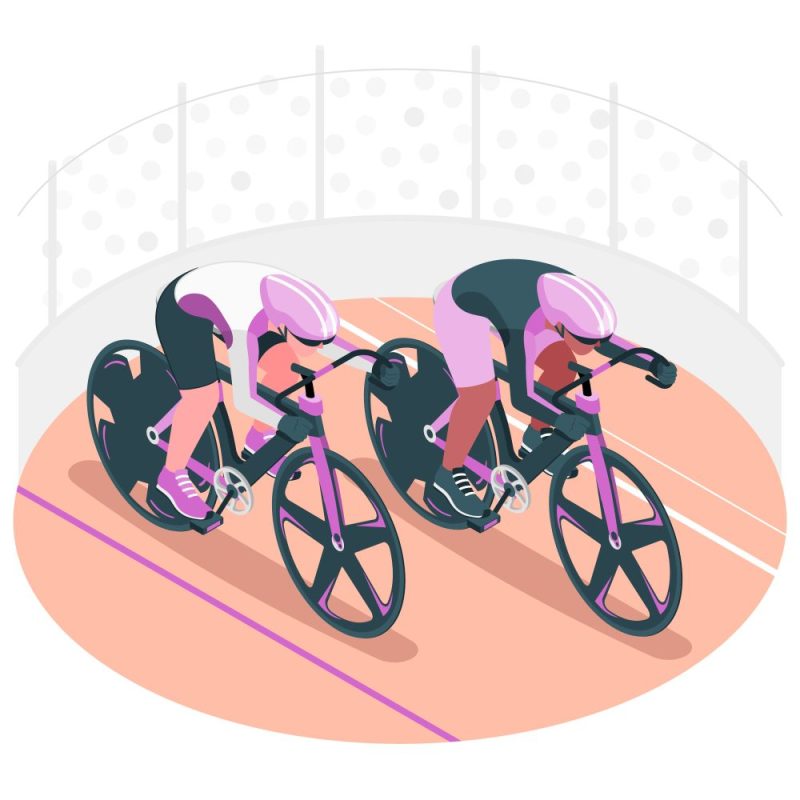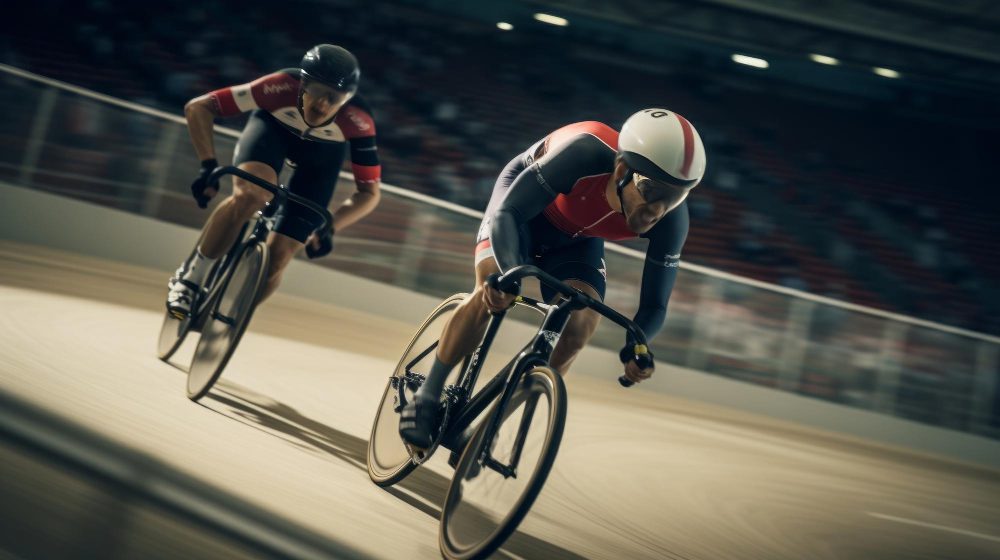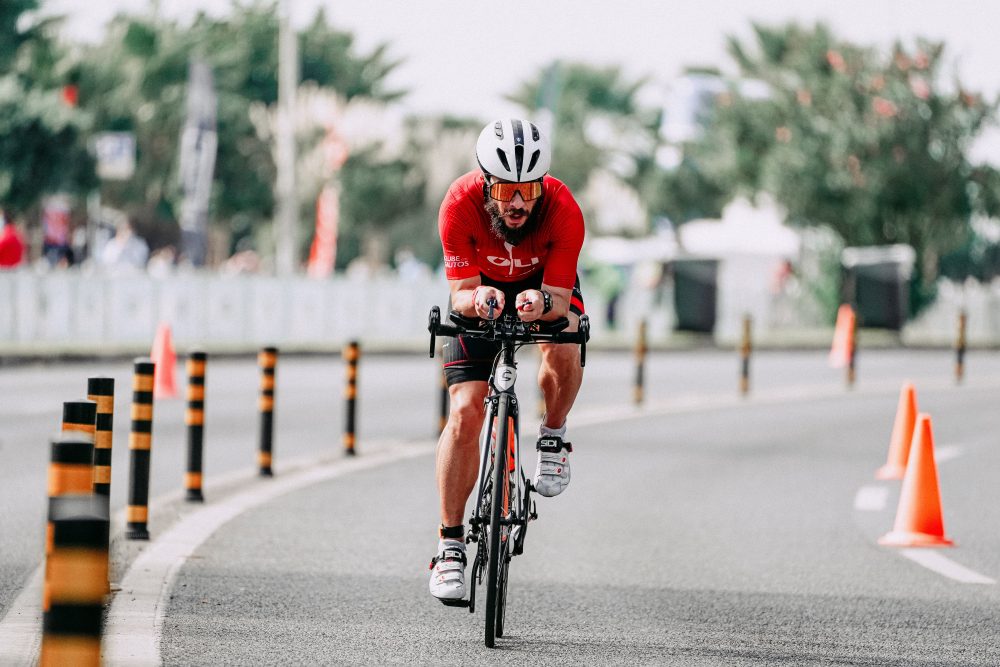What are velodrome bikes called?
Velodrome bikes, also known as track bikes, are a specific type of bicycle designed for racing on a velodrome track. These bikes are built to be lightweight, sturdy, and aerodynamic, allowing riders to reach high speeds and maneuver with precision on the banked turns of the track.
The Anatomy of a Velodrome Bike
A track bike typically has several distinctive features that set it apart from other types of bicycles:
- Fixed Gear: Velodrome bikes have a fixed gear, meaning that the rear cog is directly connected to the rear wheel, and there is no freewheel mechanism. This means that when the wheels are in motion, the pedals are always moving as well.
- No Brakes: Unlike most bicycles, track bikes do not have traditional braking systems. Instead, riders use their legs and bodyweight to slow down and stop.
- Dropped Handlebars: Track bikes feature handlebars that are lower and more aerodynamic than those found on road bikes. This allows riders to adopt a more aggressive riding position and reduce wind resistance.
- Single Gear Ratio: Velodrome bikes typically have a single gear ratio, which is optimized for the specific track and race distance. This allows riders to focus on their pedaling technique and maintaining a consistent cadence.
Track Cycling: A Brief Overview
Track cycling is a popular sport in the UK, with a rich history and dedicated velodrome facilities across the country. The racing events take place on purpose-built tracks, often indoors, called velodromes.
There are different types of track cycling events, including sprint races, endurance races, and time trials. Riders compete in various disciplines, such as individual pursuit, team pursuit, keirin, and the iconic velodrome event, the Madison.
Track cycling requires a unique set of skills and tactics. The tight turns, high speeds, and close proximity to other riders demand a combination of strength, strategy, and bike handling abilities.
The Importance of Aerodynamics
Aerodynamics plays a crucial role in track cycling, as even small reductions in wind resistance can make a significant difference in race times. Velodrome bikes are designed with this in mind, employing sleek frames, streamlined components, and advanced materials to minimize drag.
The drop handlebars, in particular, allow riders to adopt a more aerodynamic position by lowering their upper body and reducing frontal area. This optimized riding posture helps cyclists cut through the air more efficiently, enabling them to reach higher speeds.
The Olympic Legacy: Revolutionizing Track Cycling
The success of British track cyclists at the Olympic Games has reignited interest in this exhilarating sport. The development of world-class velodromes, such as the London Olympic Velodrome and the Manchester Velodrome, has further propelled the popularity of track cycling in the UK.
British cyclists like Chris Hoy, Laura Kenny, and Jason Kenny have become household names, inspiring a new generation of riders to take up track cycling. Their achievements have helped solidify the nation’s reputation as a dominant force in the world of track cycling.
The Future of Velodrome Bikes
As technology continues to advance, we can expect to see further innovations in the design and performance of velodrome bikes. The quest for improved aerodynamics, reduced weight, and enhanced power transfer continues to drive research and development in this field.
Whether you’re an aspiring track cyclist or simply intrigued by the speed and skill displayed on the velodrome, understanding the intricacies of these specialized bikes adds another layer of appreciation for the sport’s athletes and their incredible feats.
Why are velodrome bikes fixed gear?
In the world of cycling, velodrome bikes stand out for their unique feature – they have a fixed gear. Unlike regular bicycles that have multiple gears to vary the resistance and speed, velodrome bikes have only one gear ratio. But why are these bikes fixed gear? Let’s delve into the reasons behind this design choice.
The History of Fixed Gear Bikes
Fixed gear bikes, also known as fixies, have been around for decades and were originally designed for track racing on velodromes. In the early days of velodrome racing, multiple gear ratios were not necessary as races were held on flat, banked tracks. The simplicity of a single gear allowed for greater efficiency and direct power transfer, making it ideal for sprint events.
Advantages of Fixed Gear Bikes
There are several advantages to using fixed gear bikes in velodrome racing:
- Simplicity: With fewer moving parts, fixed gear bikes are simpler to maintain and repair.
- Efficiency: The direct connection between the pedals and the wheels results in a more efficient power transfer, allowing riders to maximize their speed.
- Control: Fixed gear bikes provide a greater sense of control, especially when navigating tight corners or executing precise maneuvers on the velodrome track.
Challenges of Riding Fixed Gear Bikes
While fixed gear bikes have their advantages, they also present some challenges:
- No Freewheeling: Unlike regular bikes, fixed gear bikes do not have a freewheel mechanism. This means that the pedals are always connected to the wheels, requiring constant pedaling. Riders must anticipate their speed and plan ahead for braking or stopping.
- No Gear Shifting: The lack of gears on fixed gear bikes means there is no option to adjust resistance or adapt to different terrains. Riders must rely on their strength and technique to overcome various track conditions.
Fixed gear bikes offer an exhilarating experience for track cyclists, demanding a high level of skill, control, and precision.
In Conclusion
Velodrome bikes have fixed gears because of their simplicity, efficiency, and the control they provide to riders. While they require a different approach to riding compared to regular bikes, they offer a thrilling experience on the track. Whether you’re a competitive cyclist or simply passionate about the sport, the world of velodrome racing and fixed gear bikes is definitely worth exploring.
How much are track cycling bikes?
Track cycling is an exciting and demanding sport that requires specialized equipment, including track cycling bikes. If you’re considering getting into track cycling, one of the first questions you might have is, “How much do these bikes cost?” The price of track cycling bikes can vary significantly depending on various factors.
Factors influencing the price
Several factors contribute to the cost of a track cycling bike:
- Frame material: Track cycling bikes come in different frame materials such as aluminum, carbon fiber, or steel, each with its own characteristics and price range.
- Components: The quality and level of components, such as gears, brakes, wheels, and drivetrain, can greatly impact the price of a track cycling bike.
- Brand: Bikes from well-known brands often come with a higher price tag due to their reputation for quality and performance.
It’s important to note that track cycling bikes are generally more expensive than regular road bikes due to their specialized nature and the specific requirements of competitive track racing.
Price ranges
The price range for track cycling bikes can vary widely. Entry-level track bikes typically start around £500 to £1,000, offering decent performance for beginners and enthusiasts. Mid-range track cycling bikes can range from £1,000 to £3,000, providing better components and materials for more serious riders. For professional-level track bikes, the prices can exceed £5,000, offering top-of-the-line features and cutting-edge technology.
Considerations for purchasing
When purchasing a track cycling bike, it’s essential to consider your skill level, budget, and long-term goals. If you’re a beginner or occasional rider, it may be more cost-effective to start with an entry-level bike and upgrade as your skills progress.
“Investing in a quality track cycling bike can greatly enhance your performance and enjoyment of the sport.” – Cycling Enthusiast Magazine
Before making a final decision, it’s beneficial to visit a local bike shop or consult with experienced riders to get personalized advice and recommendations. Additionally, consider trying out different bikes to ensure a proper fit and comfortable riding experience.
How many gears does a track bike have?
A track bike, also known as a velodrome bike or fixie, is a type of bicycle specifically designed for racing on a track. Unlike most bicycles that come with multiple gears for different terrains, track bikes have a single fixed gear. This means that the track bike only has one gear ratio, and the rear cog is directly connected to the rear wheel. So, how many gears does a track bike have? The answer is simple – one!
Why do track bikes have only one gear?
The main reason for track bikes having only one gear is to maximize efficiency and control on the track. Since track races are held on a smooth circuit, there is no need for a range of gears to tackle varying terrains or inclines. A single gear allows riders to maintain a constant speed and focus solely on pedaling technique and endurance.
Track bikes are typically fixed-gear, which means that the rear cog is directly connected to the rear wheel. This setup eliminates the need for a freewheel mechanism, which allows the rider to coast without pedaling. With a fixed gear, the rider is continuously connected to the bike’s motion, providing more control and responsiveness.
Advantages of a single gear on a track bike
- Simplicity: Having only one gear simplifies the bike and reduces mechanical complexity, making it easier to maintain and repair.
- Lightweight: Without the extra weight of multiple gears, track bikes are lighter, enabling faster acceleration and maneuverability on the track.
- Direct power transfer: The fixed gear system ensures an immediate transfer of power from the rider’s legs to the rear wheel, resulting in efficient pedaling and quick acceleration.
“A single gear allows riders to focus on pedaling technique and endurance without distractions.”
Do you need a license to do a bike track day?
Participating in a bike track day is an exhilarating experience that many motorcycle enthusiasts look forward to. However, if you’re new to track days, you may be wondering if you need a license to take part. Let’s dive into the details.
Licensing Requirements
In the UK, you do not need a specific license to participate in a bike track day. Both riders with a full motorcycle license and those with a provisional or learner license can take part. Track days are open to riders of all levels, from beginners to experienced riders.
Safety Precautions
Although a license is not required, it is important to ensure you meet certain safety requirements before participating in a track day. This includes wearing appropriate safety gear such as a helmet, leather suit, boots, and gloves. It is also recommended to have a mechanically sound bike and to check the track day organizer’s guidelines for any additional safety rules or requirements.
Benefits of Bike Track Days
Participating in a bike track day offers a range of benefits for riders. It provides a controlled environment where you can enjoy riding at higher speeds and pushing the limits of your bike. It allows you to improve your riding skills, learn advanced techniques, and gain confidence on the track. Additionally, track days offer a great opportunity to meet like-minded individuals and immerse yourself in the motorcycle community.
Quotes from Participants
“I was nervous about my first track day, but the experience was incredible. It’s amazing to see what you and your bike are capable of in a safe and controlled environment.” – John, track day enthusiast.
“Track days have helped me become a better rider on the road. The skills I’ve learned on the track have translated into more confidence and control during everyday riding.” – Sarah, motorcycle enthusiast.
How do you slow down on a track bike?
Riding a track bike, also known as a fixed gear or fixie, can be an exhilarating experience. With no freewheel mechanism, there is a unique challenge when it comes to slowing down and stopping. In this article, we will explore different techniques and strategies for slowing down on a track bike.
Using your legs for resistance
One of the primary methods of slowing down on a track bike is using your legs to create resistance against the pedal stroke. By applying backward pressure on the pedals, known as backpedaling, you can gradually reduce your speed. This technique requires strength and control, so it’s important to practice and build up your leg muscles for effective braking.
Skidding
Another method used by experienced track cyclists is skidding, which involves intentionally locking up the rear wheel to slow down. To execute a skid, you need to shift your weight forward, rise off the saddle, and apply strong backward pressure on the pedals while simultaneously pulling up on the handlebars. This technique requires precise timing and skill, and it’s crucial to use a dedicated skid-resistant tire for safety.
Installing a front brake
While riding a track bike without brakes is traditional, it may not be suitable for everyone, especially if you’re new to fixed-gear cycling. Installing a front brake is a common modification that provides an additional stopping power. A front brake allows you to slow down quickly and efficiently, offering more control and safety on the roads. However, it’s essential to follow local regulations regarding the use of brakes on bicycles.
Expert tip: It’s recommended to start with one method (e.g., using your legs for resistance) and gradually incorporate other techniques into your riding style as you gain confidence and experience.
Remember, no matter which technique you choose to slow down on a track bike, it’s crucial to maintain focus, be aware of your surroundings, and practice regularly to improve your skills. Stay safe and enjoy the thrill of riding a track bike!
Conclusion
Track cycling bikes can range from affordable entry-level options to high-end professional machines. The price of a track cycling bike depends on factors such as frame material, components, and brand. Keep in mind your skill level, budget, and long-term goals when making a purchasing decision. Investing in a quality track cycling bike can greatly enhance your performance and enjoyment of the sport, so take the time to research and choose wisely.
In summary, a track bike has only one gear. This single gear setup provides maximum control, efficiency, and simplicity for racing on the velodrome. With no need for shifting gears, track cyclists can focus on perfecting their pedaling technique and maintaining a consistent cadence. So, if you’re considering taking up track cycling, remember that you’ll be riding with just one gear!
In summary, you do not need a license to participate in a bike track day in the UK. However, it is essential to adhere to safety precautions and guidelines set by the track day organizer. Whether you’re a seasoned rider or a beginner, track days offer a thrilling experience and an opportunity to enhance your riding skills. So, gear up, hit the track, and enjoy the adrenaline rush!



